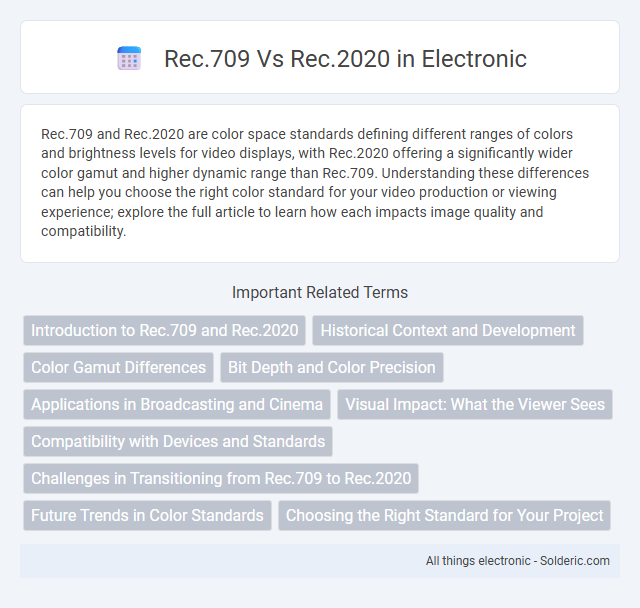Rec.709 and Rec.2020 are color space standards defining different ranges of colors and brightness levels for video displays, with Rec.2020 offering a significantly wider color gamut and higher dynamic range than Rec.709. Understanding these differences can help you choose the right color standard for your video production or viewing experience; explore the full article to learn how each impacts image quality and compatibility.
Comparison Table
| Feature | Rec.709 | Rec.2020 |
|---|---|---|
| Color Gamut | Smaller, covers standard HDTV colors | Significantly wider, supports UHD and HDR |
| Resolution | Up to 1080p (Full HD) | Supports up to 8K UHD |
| Bit Depth | 8-bit (standard HDTV) | 10-bit and 12-bit for HDR |
| White Point | D65 (6500K) | D65 (6500K) |
| Transfer Function | Gamma 2.4 | SMPTE ST 2084 (PQ) and HLG for HDR |
| Applications | Standard HDTV broadcasts, SDR content | Ultra HD TV, HDR, wide color gamut content |
Introduction to Rec.709 and Rec.2020
Rec.709 is the standard color space for high-definition television, defining precise color primaries, white point, and gamma for consistent image reproduction across HD displays. Rec.2020 expands the color gamut significantly to cover ultra-high-definition (UHD) and 4K/8K content, offering a wider range of colors that more accurately represents real-world hues with improved bit depth and dynamic range. Understanding the differences between Rec.709 and Rec.2020 helps you optimize your display settings and content creation for better visual fidelity in various viewing environments.
Historical Context and Development
Rec.709, established in 1990, became the standard for HDTV, defining color space and gamma for consistent video production and broadcasting. Rec.2020, introduced in 2012 for UHDTV, significantly expanded the color gamut and dynamic range to accommodate advancements in display technology and higher resolution content. Your choice between Rec.709 and Rec.2020 depends on the desired color accuracy and compatibility with modern displays.
Color Gamut Differences
Rec.709 offers a color gamut covering approximately 35.9% of the CIE 1931 color space, primarily designed for standard HD displays, while Rec.2020 significantly expands this range to about 75.8%, enabling richer and more vibrant colors suitable for 4K and 8K UHD content. This wider gamut in Rec.2020 supports deeper reds, greens, and blues, enhancing color accuracy and realism in compatible displays. Your choice between Rec.709 and Rec.2020 affects the visual depth and color precision of your viewing experience or content production.
Bit Depth and Color Precision
Rec.709 supports 8-bit to 10-bit color depth, offering up to 1.07 billion colors, which is standard for HDTV and ensures reliable color precision in most broadcasting scenarios. Rec.2020 significantly enhances color precision with support for 10-bit to 12-bit bit depth, enabling over 68 billion colors that provide greater subtlety and accuracy in high dynamic range (HDR) and ultra-high-definition (UHD) content. Choosing Rec.2020 extends your color gamut and precision, resulting in richer, more detailed visuals suitable for modern displays and advanced content creation.
Applications in Broadcasting and Cinema
Rec.709 is the standard color space predominantly used in HDTV broadcasting and consumer video applications, ensuring compatibility with most current displays and broadcast systems. Rec.2020, designed for Ultra High Definition (UHD) and HDR content, offers a significantly wider color gamut and higher dynamic range, making it ideal for advanced cinema production and next-generation broadcasting. Transitioning to Rec.2020 enables cinematic content creators and broadcasters to deliver richer, more lifelike visuals, enhancing viewer experience on modern UHD displays.
Visual Impact: What the Viewer Sees
Rec.2020 offers a significantly wider color gamut than Rec.709, enabling a richer and more vibrant visual experience with deeper greens, more intense reds, and brighter blues. This expanded range enhances color accuracy and realism, making images appear more lifelike on compatible displays. Your viewing experience benefits from Rec.2020's improved color depth and dynamic range, providing greater immersion and visual impact compared to the limited spectrum of Rec.709.
Compatibility with Devices and Standards
Rec.709 is widely compatible with most current TVs, monitors, and broadcasting systems due to its established use in HD content and SDR displays. Rec.2020 offers broader color gamut and higher dynamic range, but its compatibility is limited to newer UHD devices and evolving HDR standards like HDR10 and Dolby Vision. Content creators must consider device support and delivery platforms when choosing between Rec.709 and Rec.2020 for optimal color accuracy and viewer experience.
Challenges in Transitioning from Rec.709 to Rec.2020
The transition from Rec.709 to Rec.2020 presents challenges such as the need for compatible display technology that supports a wider color gamut and higher dynamic range inherent to Rec.2020 standards. Content creation and post-production workflows require significant updates to color grading tools and metadata management to accurately interpret the expanded color space. Additionally, broadcast and streaming infrastructures must evolve to handle increased bandwidth and ensure consistent color reproduction across diverse viewing environments.
Future Trends in Color Standards
Rec.2020 offers a wider color gamut and higher bit depth compared to Rec.709, positioning it as the future-standard for ultra-high-definition (UHD) and HDR content. Industry trends indicate increasing adoption of Rec.2020 in video streaming, broadcasting, and display manufacturing to enhance color accuracy and visual realism. Emerging technologies like HDR10+ and Dolby Vision rely on Rec.2020 color space to deliver richer and more immersive viewing experiences across next-generation devices.
Choosing the Right Standard for Your Project
Rec.709 and Rec.2020 differ primarily in color gamut and resolution, with Rec.2020 offering a wider color range and supporting UHD and 4K displays, whereas Rec.709 is designed for HD content. Choosing the right standard depends on your project's display requirements and target platform, as Rec.709 remains ideal for traditional HD broadcasting while Rec.2020 suits cutting-edge, high-resolution workflows. Ensuring compatibility with your audience's devices maximizes color accuracy and viewing experience.
Rec.709 vs Rec.2020 Infographic

 solderic.com
solderic.com